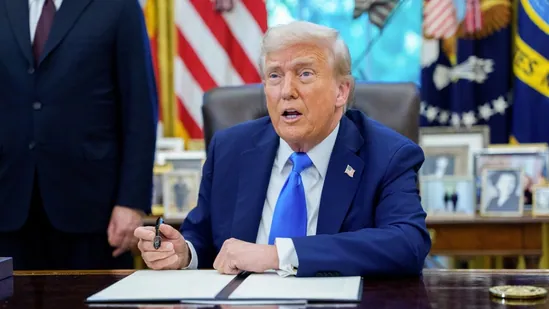On 19 September 2025 the U.S. government introduced a significant policy under a presidential proclamation titled Restriction on Entry of Certain Nonimmigrant Workers. Under this policy new H‑1B visa petitions filed after 12:01 am Eastern Daylight Time on 21 September 2025 must be accompanied by a one‑time payment of US$100,000. The fee applies only to petitioners outside the United States seeking new H‑1B visas under the “specialty occupation” category. Current H‑1B visa holders, renewals and those already in the U.S. are not subject to the fee.
These changes have sparked substantial discussion, especially among tech companies, Indian IT firms, and foreign professionals planning travel or visa filings. They are intended to reform how the United States handles skilled foreign workers while introducing higher prevailing wage standards.
Key Details of the Policy
- The proclamation takes effect on 21 September 2025 at 12:01 am EDT.
- The US$100,000 fee is one‑time per new H‑1B petition submitted on behalf of a foreign national outside the U.S. under the new policy. It is not annual.
- Existing H‑1B visa holders are exempt. So are those with petitions filed before the effective date, and those already in valid H‑1B status.
- The rule also clarifies that re‑entry into the U.S. by current visa holders is not affected by the fee. Travel does not trigger the fee for those with valid H‑1B visas.
What Does This Mean in Practice
Employer Strategy Will Shift: Many companies will become more selective about which foreign workers to sponsor under H‑1B. Only roles deemed essential or high‑skilled may be justified given the cost. Employers will re‑work hiring plans, considering whether to wait or to adjust salaries.
Job Market Distortions Likely: The revamp may increase wage demands or push employers to consider domestic recruitment more aggressively. Industries heavily reliant on H‑1B talent, ICT, engineering, biotech will feel early pressure.
Legal Questions and Uncertainty Remain: Lawyers have pointed out ambiguous language in the proclamation around terms such as “entry”, “petition”, and who counts as a “new applicant”. There may be litigation or further regulations to clarify the policy’s boundaries.
Industry Reaction, Especially in India: Industry bodies from India have welcomed the clarification that existing visa holders are exempt, calling it a relief. However they warn the fee could still disrupt operations, especially for Indian IT firms that regularly rotate staff between India and the U.S.
Financial Burden for New Applicants: For foreign nationals outside the U.S., the cost of entering via H‑1B has increased substantially. Even if they have employment offers, applying through this route now involves significantly higher financial risk and planning. This may deter some applicants or push them to consider alternative visa routes.
Broader Discussion: Policy Implications & Risks
- The policy appears designed to reduce perceived abuse of the H‑1B programme and to encourage employers to raise wages. Nevertheless it may unintentionally reduce the pool of foreign talent, particularly those not in the highest salary bands or highest demand sectors.
- The U.S. labour market could see delays in filling specialist roles if skilled applicants are discouraged by cost or complexity.
- There are concerns about fairness. Those overseas who have planned careers based on H‑1B access may find themselves impacted despite long preparation. Families may face disruption.
- The rule may lead business organisations and immigration attorneys to challenge whether the proclamation has been issued with full legal authority, especially around constitutional and statutory constraints.
EB‑5 as a Strategic Alternative
Given the increasing complexity and cost of the H‑1B pathway for many, EB‑5 becomes more attractive for certain families and professionals. Here is how it compares in light of recent changes:
- Permanent residency is the goal with EB‑5. Once investment requirements and job‑creation conditions are met, the investor and immediate family gain Green Cards.
- Cost vs stability: EB‑5 requires a substantial capital investment, but it avoids annual or petition‑based visa fees like the new H‑1B fee. Many see it as a more secure long‑term strategy.
- Use of rural EB‑5 projects may help reduce wait times, because recent reforms reserve visas for rural or high unemployment regions.
- Concurrence and flexibility: Under EB‑5, there is a possibility to file investment and adjustment of status concurrently in some cases, which may allow travel and work authorisation while the application is pending.
- Who may benefit most: Those with capital ready, families seeking stability, individuals concerned about travel interruptions, or those whose professions or sectors are less likely to get H‑1B sponsorship under tighter rules.
The Bottom Line
The U.S. government’s proclamation introducing a US$100,000 fee for new H‑1B petitions represents a major shift in immigration policy. Although existing visa holders and renewals are exempt, the move will have a material impact on how companies hire foreign talent, how individuals plan relocation, and how legal practitioners advise clients.
With growing uncertainty and cost in the H‑1B pathway, EB‑5 is increasingly seen as a viable and strategic alternative by those who can meet its investment and project criteria. For many families and high skilled professionals, now is a time to explore all available immigration options, consider longer term stability, and seek expert advice.





